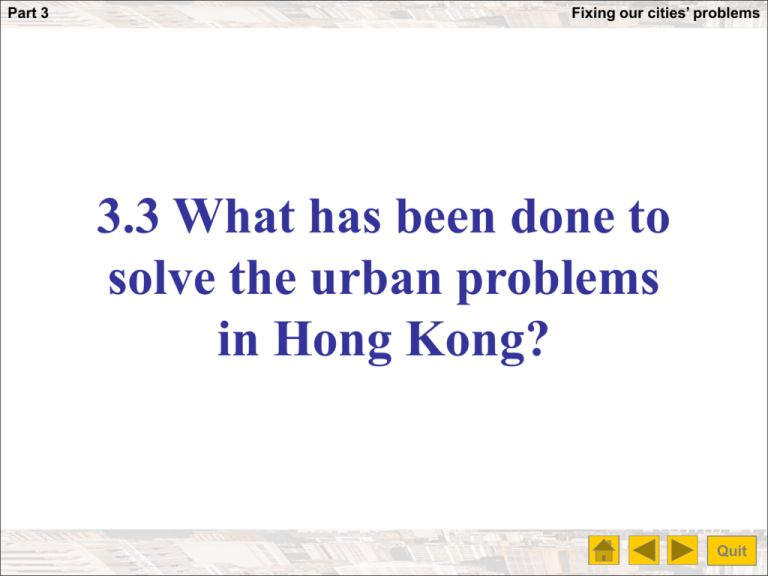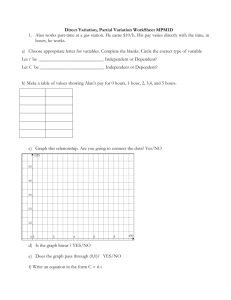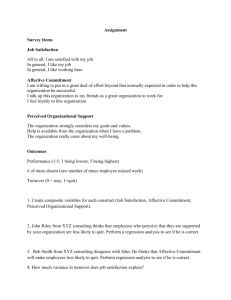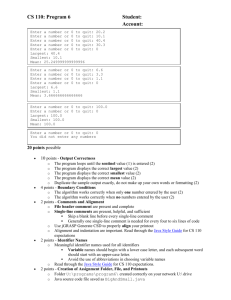Quit Part 3 Fixing our cities' problems Develop more land
advertisement

Part 3 Fixing our cities’ problems 3.3 What has been done to solve the urban problems in Hong Kong? Quit Fixing our cities’ problems Part 3 What has been done to solve the urban problems? Lower population growth Develop more land Build more roads and improve public transport Conserve the environment Build more houses Better urban planning Quit Fixing our cities’ problems Part 3 The end Quit Fixing our cities’ problems Part 3 Lower population growth The birth rate in Hong Kong is (increasing/decreasing). The government encourage people to carry out birth Control. People like small families nowadays. The death rate in Hong Kong is low. Describe the change in birth rates in Hong Kong. Quit Fixing our cities’ problems Part 3 Lower population growth Death rates: 1955 1960 1965 1970 1975 1980 1985 1990 1995 2000 2003 -- -- 5.0 5.1 4.8 5.0 4.6 5.2 5.1 5.1 5.4 Migrants: 150 immigrants from mainland China daily Population growth (1991-2001): 6 708 389 – 5 674 114 = 1 034 275 Average annual population growth rate: 1.6% The average annual population growth rate is (high/low). Quit Part 3 Fixing our cities’ problems Develop more land Reclamation Increases the size of Hong Kong Narrows the Victoria Harbour Reclaimed coastline: Straight Quit Fixing our cities’ problems Part 3 Develop more land Reclamation Reclamation increases land for urban development e.g. building new towns. Most of the land in West Kowloon is obtained from reclamation. Quit Fixing our cities’ problems Part 3 Build more houses The government has built many public housing estates to help low-income people improve their living conditions. The government also rebuilds some old public housing estates. The new estates provide more living spaces and better facilities. Quit Fixing our cities’ problems Part 3 Build more houses The Housing Authority since 1973 First public housing estate: Shek Kip Mei Types of public housing: Rental housing; Subsidized sales flats (Home ownership scheme; Private Sector Participation Scheme) 49.5 % of people live in public housing by 2005 ______ Facilities in public housing estates: Market, shopping centres, restaurants, playgrounds, games halls, car parks, etc. Quit Fixing our cities’ problems Part 3 Better urban planning planning Careful urban _____________ is a way to help solve urban problems. With good urban planning, the government can use the _____________ land more wisely. Quit Fixing our cities’ problems Part 3 Better urban planning Redevelop the old urban areas by the Urban Renewal Authority 4R strategy: Redevelopment _____________ _______________, Rehabilitation Revitalization _______________, Preservation _____________ Redevelopment: Old buildings are pulled down. Land uses are replanned. New buildings are put in place. Streets are widened and more open spaces are provided. Quit Fixing our cities’ problems Part 3 Better urban planning Redevelop the old urban areas Before and after redevelopment: (Fig. 3a-3c on p.61) Before urban renewal After urban renewal Lower Higher Old, decayed, ugly New, modern Open space Less More Land use zones Mixed Planned Living environment Poorer Better Height of building Look of building Quit Fixing our cities’ problems Part 3 Better urban planning New towns Population has been (decreasing/increasing) on Hong Kong Island and Kowloon. However, the population of the new towns has been (decreasing/increasing). Describe the change of population in different parts of Hong Kong. 1981 2001 Quit Fixing our cities’ problems Part 3 Better urban planning New towns 47.1 % of Hong Kong people live in new towns. By 2003, ____ nine new towns in Hong Kong. At present, there are _______ Tung Chung The most recent new town is ______________. Tung Chung new town Tseung Kwan O new town Quit Fixing our cities’ problems Part 3 Develop more land New towns Land uses: (e.g. Shatin on p.91) Commercial, residential, residential industrial, institutional, green belt Why is land use conflict not found in new towns? There is land use planning. Shops are provided near to the residential areas. There are plenty of open spaces and recreational land use among the other uses. Factories are grouped into certain areas. These industrial areas are separated from other land uses. Quit Fixing our cities’ problems Part 3 Build more roads and improve public transport KCR Corporation MTR Corporation KCR corporation MTR Corporation KCR Corporation ___ 9 strategic/trunk routes; ____ 12 tunnels Yuen Long to Central: Route No. 3 Tung Chung to Central: Routes No. 3 and 8 Quit Fixing our cities’ problems Part 3 Build more roads and improve public transport Which new towns do the KCR rails link up? Yuen Long, Tin Shui Wai, Tuen Mun, Tsuen Wan West rail: _____________________________________________ Shatin, Taipo, Sheungshui/Fanling East rail: ______________________________________________ On Shan, Shatin Ma On Shan rail: Ma _______________________________________ The improved road network and mass transit systems gives new _______ towns a better link between the _____ and the urban areas. Quit Fixing our cities’ problems Part 3 Conserve the environment Environmental Protection The government has set up the ___________________________ Department to promote environmental protection. What has the SAR government done to conserve the environment? Quit Fixing our cities’ problems Part 3 Air Pollution Laws and regulation Set and tighten limits to emission of waste gas from vehicles, power plants, factories, etc. Smoke test for vehicles and penalty set for smoky vehicles Require Euro diesel vehicles to install particulate reduction devices Ban the use of dirty fuels in power plants Improvement work Encourage the switch to alternative cleaner fuel, e.g. LPG taxis and light buses Assist the diesel vehicles to install particulate traps/catalytic converters Educate the public o o o o Promote eco-driving, e.g. switching off engine while waiting Encourage drivers to repair and maintain their vehicles Encourage the public to use public transport Promote energy saving Quit Fixing our cities’ problems Part 3 Water pollution Laws and regulation Set emission standards of waste sewage from factories Improvement work Build sewers network Carry out sewage treatment, e.g. the Stonecutters Sewage Treatment Works Educating the public o Launch the scheme sewage charges to teach the public the “Polluters Pay Principle” Quit Fixing our cities’ problems Part 3 Land Pollution/Solid Waste Laws and regulation Set a licensing scheme for the disposal of waste Control on the disposal of chemical waste, clinical waste, construction waste, etc. Prohibition or control of livestock keeping in the urban areas Penalty for offenses like littering, splitting, dog fouling, unauthorized display of posters Improvement work Build landfills to dispose solid waste Provide chemical waste treatment in Tsing Yi Set up the Eco Park in Tuen Mun (planned) Educate the public o Promote waste reduction: waste separation; waste recovery; waste recycling o Set the scheme of waste disposal charges: the “Polluters Pay Principle” Quit Fixing our cities’ problems Part 3 Noise Pollution Laws and regulation Set noise standards for factories and commercial operators Limit piling in construction sites to 3 to 5 hours a day Ban vehicles going into certain streets at night Improvement work Install noise barriers/screens along new roads and some old roads Build low-noise surface to new roads Improve land use planning by reducing population exposed to traffic noise, e.g. set a distance between buildings and main roads Set up pedestrian scheme Educate the public o Reduce noise Quit






